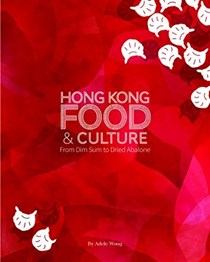Hong Kong Food & Culture
March 15, 2017 by Jenny Hong Kong Food & Culture:
From Dim Sum to Dried Abalone by Adele Wong is a book whose
content will happily be devoured by those of us who love food and
culture – a trip to Hong Kong between two vibrant red covers.
Hong Kong Food & Culture:
From Dim Sum to Dried Abalone by Adele Wong is a book whose
content will happily be devoured by those of us who love food and
culture – a trip to Hong Kong between two vibrant red covers.
This tome is an in-depth exploration
of the culinary mystique of Hong Kong. While the book contains
only sixteen recipes, it is a thorough primer on the dishes,
ingredients, people and all that encompass this fascinating region.
Hong Kong, literally translates to Fragrant Harbour, which is
certainly reflected in the photographs of the food, spices and
teas.
The profiles of artisans such as noodle makers, the diverse
purveyors of the street food scene, and highlighted restaurants
make reading this book an incredible journey that transports you
magically to the crowded street stalls and shops where noodles are
stretched endlessly long and woks are red hot.

The sixteen recipes contained are more about technique than
precise measurements as you will see by the recipe shared below.
The book is a culinary and cultural education packed with a wealth
of knowledge, gorgeous photographs and delicious food.
Special thanks to Man Mo Media for sharing the Stir-Fried Beef with Garlic Shoots recipe with our members and for providing two copies to be given away worldwide on our contest page. Photographs courtesy of Man Mo Media.
 STIR-FRIED BEEF WITH GARLIC SHOOTS
STIR-FRIED BEEF WITH GARLIC SHOOTS
4 servings
In Cantonese cooking, beef is mostly presented as meatballs or
slices. Stir-fried beef slices with different types of leafy greens
make an easy and popular dish in both restaurants and homes alike.
You can also try tenderizing the beef if you prefer softer, chewier
textures.
Ingredients
4 taels (150g) beef
1 batch garlic shoots
Onion
Ginger
Garlic
Chinese wine
Peanut oil
Cornstarch
Method
Cut the garlic shoot into 2-inch pieces and slice onion. Dice garlic and cut ginger into slices. Cut beef into 2-inch-long slices. Heat the wok over high heat, add peanut oil and fry ginger and garlic until fragrant. Add in onion and stir-fry for about 2 minutes. Add garlic shoots and stir-fry until half cooked. Remove garlic shoot and onion from wok.
Add more peanut oil, and then toss in beef slices. Stir-fry until about 70 percent cooked, and put vegetables back into wok. Add one teaspoon water and Chinese wine, put the lid on, and let steam.
Meanwhile, mix cornstarch with water. Add mixture into wok to thicken sauce and intensify flavors. When sauce sticks to ingredients, serve.
Categories
- All Posts (6940)
- Antipasto (2135)
- Author Articles (247)
- Book News (935)
- Cookbook Giveaways (983)
- Cookbook Lovers (257)
- Cooking Tips (109)
- Culinary News (299)
- Food Biz People (552)
- Food Online (791)
- Holidays & Celebrations (272)
- New Cookbooks (149)
- Recipes (1500)
- Shelf Life With Susie (231)
- What's New on EYB (133)
Archives
Latest Comments
- Pamsy on What foods do you look forward to the most for each season?
- Pamsy on How cookbooks can help build resilience
- DarcyVaughn on Danube Cookbook Review and Giveaway
- hettar7 on JoyFull – Cookbook Review & Giveaway
- eliza on What foods do you look forward to the most for each season?
- kmwyman on Rooza by Nadiya Hussain – Cookbook Review and Giveaway
- Maryd8822 on The Golden Wok – Cookbook Giveaway
- Dendav on Danube Cookbook Review and Giveaway
- sanfrannative on Rooza by Nadiya Hussain – Cookbook Review and Giveaway
- darty on Danube Cookbook Review and Giveaway